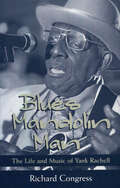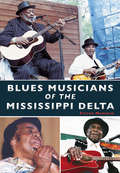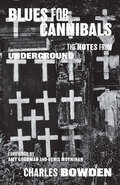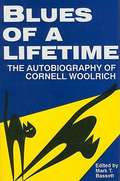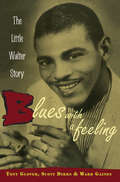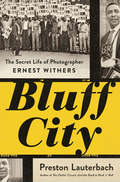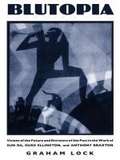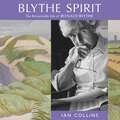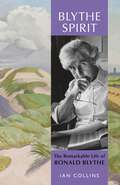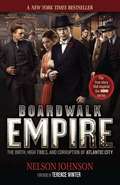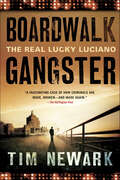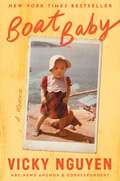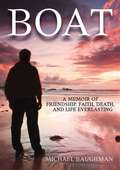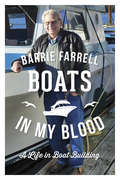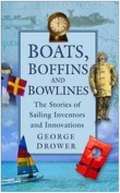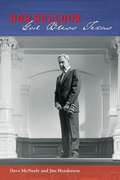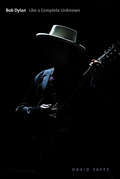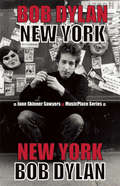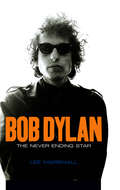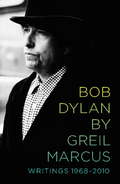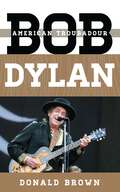- Table View
- List View
Blues Mandolin Man: The Life and Music of Yank Rachell
by Richard CongressYank Rachell and his mandolin playing style moved every musician lucky enough to hear him perform in the early sixties. When he died in April 1997, he left behind a stack of unanswered requests to tour Europe and to play blues festivals in the United States. In Blues Mandolin Man: The Life and Music of Yank Rachell, Richard Congress delivers the first biography of a family man whose playing inspired and energized the likes of David Honeyboy Edwards, Sleepy John Estes, and Henry Townsend. No other biography discusses the mandolin's influence and role in the blues. Guitar great Ry Cooder said, "Yank's style fascinated me because it had a lot of power and it's very raw-and what a great thing to do, just attack this little instrument like that." Charlie Musselwhite, the noted harp player, worked with Rachell and club hopped in Chicago with the elder bluesman. "He just had a great spirit about him," Musselwhite said of Rachell's playing and singing, "really just shouting it out. If the world was made up of people like Yank Rachell it would be a wonderful place to live." Blues Mandolin Man chronicles the life, times, and music of a man who was born into a family of sharecroppers in 1910 in rural western Tennessee. An active musician for 75 years, Rachell mastered several musical instruments and first recorded for Victor in Memphis in 1929. Through the blues, Rachell's world expanded to include Chicago, New York, recording studios and, after the sixties, radio, TV, and national and European tours. Yank's recollections reveal new information about personalities and events that will delight blues history buffs. Rich appendixes detail Yank's mandolin and guitar style and his place in the blues tradition. For this book Richard Congress, who reissued two of Rachell's old LPs in CD format, worked closely with him to record memories spanning decades of blues playing. Congress tells a compelling and engaging story about a colorful and thoughtful character who as a child picked cotton and plowed a field behind a mule, who grew to manhood coping with the southern Jim Crow system, and who participated in the creation and perpetuation of the blues.
Blues Musicians of the Mississippi Delta
by Steven ManheimThe Mississippi Delta blues run as deep and mysterious as the beautiful land from where the music originates. Blues legends B.B. King, Muddy Waters, John Lee Hooker, Howlin' Wolf, Sonny Boy Williamson, and countless other greats came from this region. The Delta blues, born as work songs in Mississippi cotton fields, was played on city street corners and in rural juke joints. With the Great Migration of African Americans in the first half of the 20th century, the Delta blues also made its way from Mississippi to Chicago. The sound of the blues would become the blueprint for the birth of rock and roll in Memphis in the 1950s. The era of the great Delta blues musicians is over, but their legacy remains an important chapter in American music. This book contains images of these important performers and the rich Delta landscapes that influenced their music.
Blues for Cannibals: The Notes from Underground
by Charles BowdenThe author of Murder City and Down by the River reflects on the destructive nature of American culture.Cultivated from the fierce ideas seeded in Blood Orchid, Blues for Cannibals is an elegiac reflection on death, pain, and a wavering confidence in humanity&’s own abilities for self-preservation. After years of reporting on border violence, sex crimes, and the devastation of the land, Bowden struggles to make sense of the many ways in which we destroy ourselves and whether there is any way to survive. Here he confronts a murderer facing execution, sex offenders of the most heinous crimes, a suicidal artist, a prisoner obsessed with painting portraits of presidents, and other people and places that constitute our worst impulses and our worst truths. Painful, heartbreaking, and forewarning, Bowden at once tears us apart and yearns for us to find ourselves back together again.&“A thrillingly good writer whose grandness of vision is only heightened by the bleak originality of his voice.&” —Ron Hansen, The New York Times Book Review &“A major literary work of profound social consciousness . . . [Bowden] writes with the intensity of Joan Didion, the voracious hunger of Henry Miller, the feral intelligence and irony of Hunter Thompson, and the wit and outrage of Edward Abbey . . . This is gutsy, soulful, pyrotechnic, significant. And transformative writing.&” —Donna Seaman, Chicago Tribune &“A vivid, lyrical journey through the American Southwest . . . [but] this book is no travelogue. Rather, it is a visceral exploration of a much darker landscape, that of the human psyche.&” —Debra Ginsberg, The San Diego Union-Tribune&“A book of absolutely furious beauty . . . At the height of [Bowden&’s] rapturous indignation, with majestic lamentations stretching out almost to the snapping point, he sounds like Walt Whitman in a very bad mood . . . Sweet bloody Jerusalem, when he&’s cooking, who can touch him?&” —David Kipen, San Francisco Chronicle
Blues of a Lifetime
by Mark T. BassettBlues of a Lifetimeis essential reading for people interested in suspense novelist Cornell Woolrich, author of Rear Window. Woolrich's autobiography includes accounts of his working methods, his family and home, memories of childhood, college experience, and his philosophy of life.
Blues with a Feeling: The Little Walter Story
by Tony Glover Scott Dirks Ward GainesWhenever you hear the prevalent wailing blues harmonica in commercials, film soundtracks or at a blues club, you are experiencing the legacy of the master harmonica player, Little Walter. Immensely popular in his lifetime, Little Walter had fourteen Top 10 hits on the R&B charts, and he was also the first Chicago blues musician to play at the Apollo. Ray Charles and B.B. King, great blues artists in their own right, were honored to sit in with his band. However, at the age of 37, he lay in a pauper's grave in Chicago. This book will tell the story of a man whose music, life and struggles continue to resonate to this day.
Bluff City: The Secret Life Of Photographer Ernest Withers
by Preston LauterbachThe little-known story of an iconic photographer, whose work captured—and influenced—a critical moment in American history. Who was Ernest Withers? Most Americans may not know the name, but they do know his photographs. Withers took some of the most legendary images of the 1950s and ’60s: Martin Luther King, Jr., riding a newly integrated bus in Montgomery, Alabama; Emmett Till’s uncle pointing an accusatory finger across the courtroom at one of his nephew’s killers; scores of African-American protestors, carrying a forest of signs reading "I am a man." But while he enjoyed unparalleled access to the inner workings of the civil rights movement, Withers was working as an informant for the FBI. In this gripping narrative history, Preston Lauterbach examines the complicated political and economic forces that informed Withers’s seeming betrayal of the people he photographed. Withers traversed disparate worlds, from Black Power meetings to raucous Memphis nightclubs where Elvis brushed shoulders with B.B. King. He had a gift for capturing both dramatic historic moments and intimate emotional ones, and it may have been this attention to nuance that made Withers both a brilliant photographer and an essential asset to the FBI. Written with similar nuance, Bluff City culminates with a riveting account of the 1968 riot that ended in violence just a few days before Dr. King’s death. Brimming with new information and featuring previously unpublished and rare photographs from the Withers archive not seen in over fifty years, Bluff City grapples with the legacy of a man whose actions—and artistry—make him an enigmatic and fascinating American figure.
Blutopia: Visions of the Future and Revisions of the Past in the Work of Sun Ra, Duke Ellington, and Anthony Braxton
by Graham LockIn Blutopia Graham Lock studies the music and thought of three pioneering twentieth-century musicians: Sun Ra, Duke Ellington, and Anthony Braxton. Providing an alternative to previous analyses of their work, Lock shows how these distinctive artists were each influenced by a common musical and spiritual heritage and participated in self-conscious efforts to create a utopian vision of the future. A century after Ellington's birth, Lock reassesses his use of music as a form of black history and compares the different approaches of Ra, a band leader who focused on the future and cosmology, and Braxton, a contemporary composer whose work creates its own elaborate mythology. Arguing that the majority of writing on black music and musicians has--even if inadvertently--incorporated racial stereotypes, he explains how each artist reacted to criticism and sought to break free of categorical confines. Drawing on social history, musicology, biography, cultural theory, and, most of all, statements by the musicians themselves, Lock writes of their influential work. Blutopia will be a welcome contribution to the literature on twentieth-century African American music and creativity. It will interest students of jazz, American music, African American studies, American culture, and cultural studies.
Blythe Spirit: The Remarkable Life of Ronald Blythe
by Ian Collins'An intimate and insightful portrait of the peerless observer of rural life' RICHARD MABEY'Moving, candid, vivid, it is all that we could hope for in a memoir of this unique and treasured writer' ROWAN WILLIAMS'As a boy I dreamed of scholars and saints wandering around markets and cornfields, and of artists and poets sitting under the trees.'Ronald Blythe (1922-2023), author of the inimitable Akenfield, was a prolific and poetic chronicler of rural and spiritual life, nature and literature. He spent a joyful century close to his Suffolk roots, time travelling in his imagination and publishing forty books and thousands of essays. His wide creative network included John and Christine Nash, Cedric Morris, Benjamin Britten, E. M. Forster, Patricia Highsmith and Richard Mabey.From finding Thomas Hardy in February rain and John Clare in country tracks, to talking to his white cat and reading through a dragonfly's wings, the Blythe gift was to marvel in the everyday. His writing was intimate, meditative and often laced with a wry humour, inviting readers to share his enchanting perspective on the world. Yet few knew the 'real' Ronald Blythe. Leaving school at 14, he educated himself in libraries, churches and walks in the East Anglian landscape. He never spoke about early poverty and traumatic experience in the war, while his sexuality was kept private except from those closest to him.Drawing on unparalleled access to letters, notebooks, published works, drafts, and conversations from decades of friendship, Ian Collins tells the full story of Ronald Blythe for the first time. The result is a sensitive, revelatory portrait which celebrates a fascinating, complex man and casts new light on one of our greatest writers.
Blythe Spirit: The Remarkable Life of Ronald Blythe
by Ian Collins'An intimate and insightful portrait of the peerless observer of rural life' RICHARD MABEY'Moving, candid, vivid, it is all that we could hope for in a memoir of this unique and treasured writer' ROWAN WILLIAMS'As a boy I dreamed of scholars and saints wandering around markets and cornfields, and of artists and poets sitting under the trees.'Ronald Blythe (1922-2023), author of the inimitable Akenfield, was a prolific and poetic chronicler of rural and spiritual life, nature and literature. He spent a joyful century close to his Suffolk roots, time travelling in his imagination and publishing forty books and thousands of essays. His wide creative network included John and Christine Nash, Cedric Morris, Benjamin Britten, E. M. Forster, Patricia Highsmith and Richard Mabey.From finding Thomas Hardy in February rain and John Clare in country tracks, to talking to his white cat and reading through a dragonfly's wings, the Blythe gift was to marvel in the everyday. His writing was intimate, meditative and often laced with a wry humour, inviting readers to share his enchanting perspective on the world. Yet few knew the 'real' Ronald Blythe. Leaving school at 14, he educated himself in libraries, churches and walks in the East Anglian landscape. He never spoke about early poverty and traumatic experience in the war, while his sexuality was kept private except from those closest to him.Drawing on unparalleled access to letters, notebooks, published works, drafts, and conversations from decades of friendship, Ian Collins tells the full story of Ronald Blythe for the first time. The result is a sensitive, revelatory portrait which celebrates a fascinating, complex man and casts new light on one of our greatest writers.
Blythe Spirit: The Remarkable Life of Ronald Blythe
by Ian Collins'Moving, candid, vivid, it is all that we could hope for in a memoir of this unique and treasured writer' ROWAN WILLIAMS'An unusually intimate and affectionate portrait' PATRICK BARKHAM, GUARDIAN'As a boy I dreamed of scholars and saints wandering around markets and cornfields, and of artists and poets sitting under the trees.'Ronald Blythe (1922-2023), author of the inimitable Akenfield, was a prolific and poetic chronicler of rural and spiritual life, nature and literature. He spent a joyful century close to his Suffolk roots, time travelling in his imagination and publishing forty books and thousands of essays. His wide creative network included John and Christine Nash, Cedric Morris, Benjamin Britten, E. M. Forster, Patricia Highsmith and Richard Mabey.From finding Thomas Hardy in February rain and John Clare in country tracks, to talking to his white cat and reading through a dragonfly's wings, the Blythe gift was to marvel in the everyday. His writing was intimate, meditative and often laced with a wry humour, inviting readers to share his enchanting perspective on the world. Yet few knew the 'real' Ronald Blythe. Leaving school at 14, he educated himself in libraries, churches and walks in the East Anglian landscape. He never spoke about early poverty and traumatic experience in the war, while his sexuality was kept private except from those closest to him.Drawing on unparalleled access to letters, notebooks, published works, drafts, and conversations from decades of friendship, Ian Collins tells the full story of Ronald Blythe for the first time. The result is a sensitive, revelatory portrait which celebrates a fascinating, complex man and casts new light on one of our greatest writers.
Bo Jackson
by John RolfeA biography of the star athlete who plays both professional baseball and football.
Bo Knows Bo: The Autobiography of a Ballplayer
by Bo Jackson Dick SchaapAutobiography of the famous baseball player and football player Bo Jackson.
Boardwalk Empire: The Birth, High Times, and Corruption of Atlantic City
by Nelson JohnsonTalks about the hidden history of Atlantic City,from its founding as a health resort,its golden age,its post-prohibition fall that continued for decades and its rebirth as a casino resort town.
Boardwalk Gangster: The Real Lucky Luciano
by Tim NewarkFor the first twenty-five years of his criminal career, Charles "Lucky" Luciano was a vicious mobster who rose to become the multimillionaire king of the New York underworld. For the next twenty-five years of his life, Luciano was a legend---but a fake master criminal without real power, his evil reputation manipulated and maintained by the government agents who had put him behind bars. Drawing on secret government documents from archives in the United States and Europe, this myth-busting biography tells the real story from Luciano's early days as a top hit man for the Mob to his exploits running sex and narcotics empires. His criminal career abruptly ended with conviction and imprisonment, but his reputation was only enhanced by rumors that he was winning World War II for the Allies in Sicily and the Mediterranean. Now, for the first time, author Tim Newark exposes the truth about what Luciano really did do to help the Allies in the war. With his expulsion from the United States after the war ended, Luciano returned to Italy. He was reputed to have overseen a massive transatlantic narcotics network and became the arch-villain for international law enforcement agencies. But Newark reveals how Luciano really spent his twilight years. Lucky Luciano: The Real and the Fake Gangster turns accepted Mafia history on its head with an extraordinary story that has never been told before.
Boat Baby: A Memoir
by Vicky NguyenIn a memoir where heroism meets humor, NBC News anchor and correspondent Vicky Nguyen tells the story of her family’s daring escape from communist Vietnam and her unlikely journey from refugee to reporter with laughter and fierce love. <p> Starting in 1975, Vietnam’s “boat people”—desperate families seeking freedom—fled the Communist government and violence in their country any way they could, usually by boat across the South China Sea. Vicky Nguyen and her family were among them. Attacked at sea by pirates before reaching a refugee camp in Malaysia, Vicky’s family survived on rations and waited months until they were sponsored to go to America. But deciding to leave and start a new life in a new country is half the story…figuring out how to be American is the other. <p> Boat Baby is Vicky’s memoir of growing up in America with unconventional Vietnamese parents who didn’t always know how to bridge the cultural gaps. It’s a childhood filled with misadventures and misunderstandings, from almost stabbing the neighborhood racist with a butter knife to getting caught stealing Cosmo in the hope of learning Do You Really Think You Know Everything About Sex? <p> Vicky’s parents approached life with the attitude, “Why not us?” In the face of prejudice, they taught her to be gritty and resilient, skills Vicky used as she combatted stereotyping throughout her career, fending off the question “Aren’t you Connie Chung?” to become a leading Asian American journalist on television. <p> She delivers a uniquely transparent account of her life, revealing how she negotiated her salary in a competitive industry, the challenges of starting a family, and the struggle to be a dutiful daughter. Funny, nostalgic, and poignant, Boat Baby is a testament to the messy glue that bonds a family. In the tradition of We Are Dreamers by Simu Liu and Dear Girls by Ali Wong, Vicky Nguyen offers an optimistic story full of heart that illuminates the promise of what America can be. <b>New York Times Bestseller</b>
Boat: A Memoir of Friendship, Faith, Death, and Life Everlasing
by Michael BaughmanWhen ten-year-old Michael Baughman moves to Hawaii with his parents, he is troubled and confused. His father doesn't provide the guidance Baughman needs and the boy doesn't know who to turn to. When a larger-than-life Hawaiian "beachboy" named Boat takes Baughman under his wing, the boy finds a teacher and mentor. Boat is 285 pounds of solid muscle but gentle spirituality, and he introduces the boy to the ways of Hawaiian mysticism, offering simple, profound wisdom that helps Baughman thrive in an otherwise lonely childhood. Even after Baughman leaves the islands seven years later, the unlikely friendship endures for the rest of Boat's life, influencing and inspiring the author to this day. Baughman's narrative begins with a distressed boy at a Pittsburgh Pirates baseball game and ends more than six decades later with himself as a content old man experiencing a miracle in Mexico. With a photographic memory, Baughman recalls virtually verbatim every significant conversation he had with Boat. Boat spoke Hawaiian Pidgin English, and its unique lilt and rhythm grace this touching memoir. A testament to friendship and the revelations provoked by wisdom in unexpected places.
Boats in My Blood: A Life in Boat Building
by Barrie FarrellThe Farrell name is respected all along the British Columbia coast. Barrie's father, Allen Farrell, was a much loved eccentric who created offshore sailing vessels from beachcombed lumber using only basic hand tools.Barrie built his first boat in his early teens using only a dull handsaw, a rusty block plane and an old hammer with one claw. Despite his Grade Six education, Barrie became one of the leading innovators when fibreglass first became available. His designs incorporated flowing curves and shaped details that were not possible with wood. Barrie was one of the first to realize that modern fishboats needed to be fast, and consequently, his gillnetters and trollers dominated the BC salmon fleet in the 1970s and 1980s. By the late 1990s, he had built over 300 commercial and pleasure boats and left a profound stamp on West Coast boat building.Boats in My Blood isn't just about the boats. Barrie also shares the story of his life-the highs and the lows. His memories of growing up in Pender Harbour provide an amusing picture of fishing village life in the 1950s, and his sharp eye for character makes for many amusing anecdotes. He is frank about his periodic bouts of overzealous partying and his bad business dealings, but through it all his engaging character and unquenchable good nature shine through. Boats in My Blood is a fascinating chronicle of a life devoted to the art of the boat.
Boats, Boffins and Bowlines: The Stories of Sailing Inventors and Innovations
by George DrowerMany of us know the story of modern sailing pioneers - Dame Ellen MacArthur and Francis Chichester, Claire Francis and the challengers of the Americas Cup - but what about those unsung heroes who invented the mechanisms and technology which enabled sailors to speed across the oceans and navigate more safely? This fascinating book reveals the extraordinary stories behind the apparatus which many take for granted. From cloud classification and screw propellers to radio telephones and the measurement of tides, from the sextant to the first fibreglass boat, this collection of stories, with a foreword by Ben Ainslie, Olympic gold medal winner, will inspire and intrigue sailors everywhere.
Bob Bullock
by Dave McneelyRenowned for his fierce devotion to the people of Texas—as well as his equally fierce rages and unpredictable temper—Bob Bullock was the most powerful political figure in Texas at the end of the twentieth century. First elected to the Texas House of Representatives in 1956, Bullock held several key statewide posts before capturing the lieutenant governor’s office in 1990. Though nominally the state’s number two official, Bullock in fact became Texas’s top power broker, wielding tremendous influence over the legislative agenda and state budget through the 1990s while also mentoring and supporting a future president—George W. Bush. In this lively, yet thoroughly researched biography, award-winning journalists Dave McNeely and Jim Henderson craft a well-rounded portrait of Bob Bullock, underscoring both his political adroitness and his personal demons. They trace Bullock’s rise through state government as Assistant Attorney General, Secretary of State, State Comptroller, and Lieutenant Governor, showing how he increased the power of every office he held. The authors spotlight Bullock’s substantial achievements, which included hiring an unprecedented number of women and minorities, instituting a performance review to increase the efficiency of state agencies, restructuring the public school funding system, and creating the state’s first water conservation and management plan.
Bob Dylan
by David YaffeBob Dylan is an iconic figure in American musical and cultural history, lauded by Time magazine as one of the hundred most important people of the twentieth century. For nearly fifty years the singer-songwriter has crafted his unique brand of music, from his 1962 self-titled debut album to 2009's #1 hit Together Through Life, appealing to everyone from baby boomers to the twenty-somethings who storm the stage at his concerts. In Bob Dylan: Like a Complete Unknown, literary scholar and music critic David Yaffe considers Dylan from four perspectives: his complicated relationship to blackness (including his involvement in the civil rights movement and a secret marriage with a black backup singer), the underrated influence of his singing style, his fascinating image in films, and his controversial songwriting methods that have led to charges of plagiarism. Each chapter travels from the 1960s to the present, offering a historical perspective on the many facets of Dylan's life and career, exploring the mystery that surrounds the enigmatic singer and revealing the complete unknown Dylan.
Bob Dylan
by June Skinner SawyersPacked with information, savvy insights, and surprising facts, this guide to Dylan's years in New York City examines the role that the city played in the creation of his music, the evolution of his creative process, and the continual reinvention of his public persona.In the landscape of Manhattan, Dylan created words and sounds that redefined the possibilities of popular music throughout the world. Chronicling where he lived, worked, and played, this book offers an evocative portrait of the city, especially its folk scene during the 1960s. With street maps featuring more than 50 sites-from fleabag hotels and avant-garde clubs to tiny coffeehouses and vast concert halls-readers can navigate Bob Dylan's New York and experience the sites and sounds that influenced the singer, such as Café Wha?; the Chelsea Hotel; Columbia's Studio A, where he recorded songs such as "Desolation Row" and "Positively 4th Street;" the Decker Building, where he hung out with Andy Warhol and Nico; the Delmonico Hotel, where he introduced the Beatles to marijuana; and the Bitter End, where he spent much of the summer of 1975 playing pool and guitar.
Bob Dylan
by Lee MarshallBob Dylan's contribution to popular music is immeasurable. Venerated as rock's one true genius, Dylan is considered responsible for introducing a new range of topics and new lyrical complexity into popular music. Without Bob Dylan, rock critic Dave Marsh once claimed, there would be no popular music as we understand it today. As such an exalted figure, Dylan has been the subject of countless books and intricate scholarship considering various dimensions of both the man and his music. This book places new emphasis on Dylan as a rock star. Whatever else Dylan is, he is a star - iconic, charismatic, legendary, enigmatic. No one else in popular music has maintained such star status for so long a period of time. Showing how theories of stardom can help us understand both Bob Dylan and the history of rock music, Lee Marshall provides new insight into how Dylan's songs acquire meaning and affects his relationship with his fans, his critics and the recording industry. Marshall discusses Dylan's emergence as a star in the folk revival (the "spokesman for a generation") and the formative role that Dylan plays in creating a new type of music - rock - and a new type of star. Bringing the book right up to date, he also sheds new light on how Dylan's later career has been shaped by his earlier star image and how Dylan repeatedly tried to throw off the limitations and responsibilities of his stardom. The book concludes by considering the revival of Dylan over the past ten years and how Dylan's stardom has developed in a way that contains, but is not overshadowed by, his achievements in the 1960s.
Bob Dylan and Philosophy: It's Alright, Ma (I'm Only Thinking)
by Peter Vernezze Carl J. PorterIn Bob Dylan and Philosophy, eighteen philosophers analyze Dylan's ethical positions, political commitments, views on gender and sexuality, and his complicated and controversial attitudes toward religion.
Bob Dylan by Greil Marcus: Writings 1968-2010
by Greil MarcusHis foremost interpreter revisits more than forty years of listening to Dylan?weaving individual moods and moments into a brilliant history of their changing times
Bob Dylan: American Troubadour (Tempo: A Rowman & Littlefield Music Series on Rock, Pop, and Culture)
by Donald Brown&“The book&’s strength is a thorough assessment of Dylan&’s career, album by album, song by song. Both longtime fans and newcomers . . . will appreciate.&” —Library Journal With Bob Dylan&’s receipt of the Nobel Prize in Literature, his iconic status as an American musical, cultural, and poetic giant has never been more apparent. Bob Dylan: American Troubadour is the first book to look at Dylan&’s career, from his first album to his masterpiece Tempest. Donald Brown provides insightful critical commentary on Dylan&’s prolific body of work, placing Dylan&’s career in the context of its time in order to assess the relationship of Dylan&’s music to contemporary American culture. Each chapter follows the shifting versions of Dylan, from his songs of conscientious social involvement to more personal exploratory songs; from his influential rock albums of the mid-1960s to his adaptations of country music; from his three very different tours in the 1970s to his &“born again&” period as a proselytizer for Christ and his frustrations as a recording and performing artist in the 1980s; from his retrospective importance in the 1990s to the refreshingly vital albums he has been producing in the 21st century. &“This concise examination of the Dylan corpus is especially good for younger generations who may want to better understand how a musician in his early seventies can still be so compelling and relevant in twenty-first-century America.&”. —Booklist &“Fascinating . . . Highly recommended. All readers. —Choice Reviews &“A nearly album by album retrospective of one of the most culturally significant and musically influential musicians in modern history.&” —Examiner &“A must read for Dylan enthusiasts.&” —Journal of American Culture
